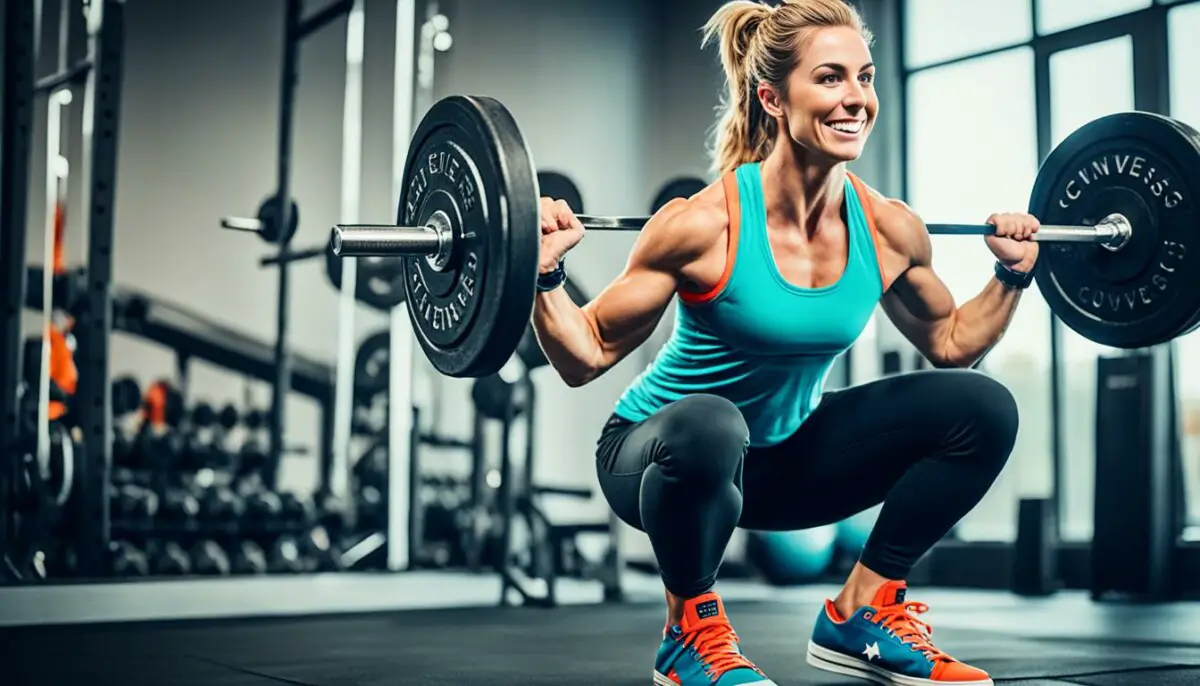Last Updated on 3 months by Francis
Converse shoes have long been a staple in the world of fashion, known for their timeless style and versatility. But did you know that Converse shoes can also elevate your workout game? Whether you’re into weightlifting, strength training, or any other type of athletic activity, Converse shoes have the potential to be your new go-to footwear.
When it comes to lifting, having the right shoes can make all the difference in your performance and safety. That’s where Converse shoes come in. With their durable construction, supportive features, and cost-effectiveness, they offer a compelling option for those looking for strength training footwear.
Contents
Key Takeaways:
- Converse shoes are not just for style; they can also provide the necessary support and features for weightlifting and strength training.
- Benefits of Converse shoes for lifting include a flat sole for improved balance and technique, superior ground reaction force, optimal outsole grip for better stability, and a high-top design for increased ankle support.
- Drawbacks of wearing Converse for lifting include a slightly more rigid midsole, lack of raised heels, minimal cushioning, and reduced traction support.
- Converse shoes can be a suitable choice for beginners or intermediate lifters looking for a more affordable and versatile option.
- When choosing Converse shoes for lifting, both high tops and low tops can be suitable options, depending on your individual needs and preferences.
Why Are Converse Good For Weightlifting?
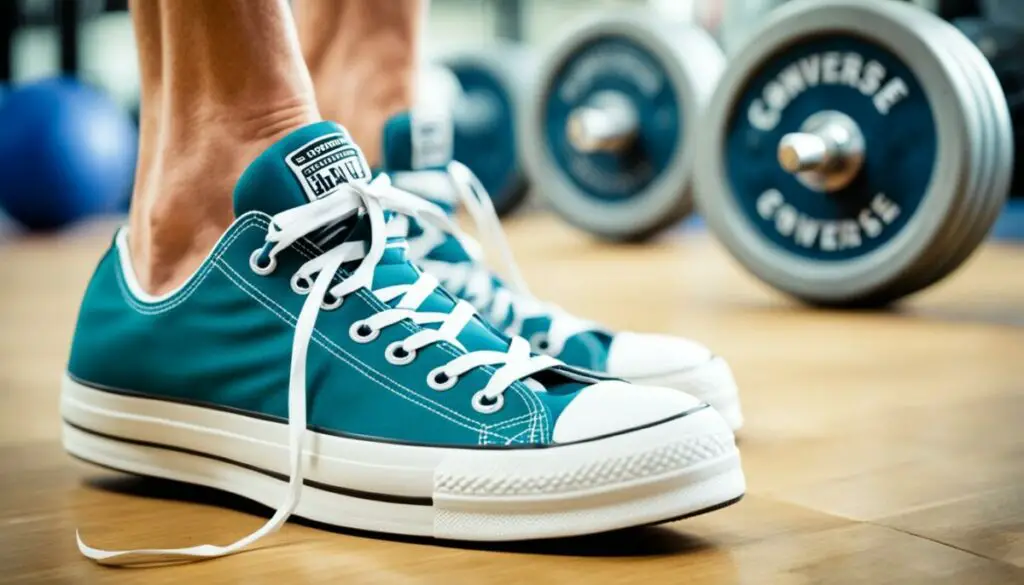
When it comes to weightlifting, having the right shoes can make a significant difference in your performance and safety. Converse shoes, known for their timeless style, also offer several features that make them a good choice for weightlifting.
Flat Sole for Balance and Technique
Converse shoes are famous for their flat sole design, which provides improved balance and technique during lifts. The flat sole allows for a more natural foot position, promoting proper alignment and stability throughout your movements.
Ground Reaction Force and Stability
The flat sole of Converse shoes also enhances ground reaction force, enabling you to generate more power and stability while lifting. This improved connection with the ground helps you maintain control and stability throughout your lifts.
Ankle Support for Injury Prevention
One of the key advantages of Converse shoes is their high-top design, which offers increased ankle support. This feature is particularly beneficial for weightlifters as it helps reduce the risk of ankle injuries during heavy lifts and provides extra stability.
Durable and Breathable Construction
Converse shoes are known for their durability, making them a reliable choice for weightlifting. The sturdy materials used in their construction offer long-lasting performance, even during intense training sessions. Additionally, Converse shoes are breathable, allowing proper airflow and keeping your feet cool and comfortable.
Cost-Effective Option
Compared to specialized weightlifting shoes, Converse shoes are a cost-effective alternative. They offer many of the same benefits at a more affordable price point, making them accessible to a wide range of lifters.
Overall, Converse shoes provide a combination of style and functionality that make them a suitable choice for weightlifting. Their flat sole, ground reaction force, ankle support, durability, breathability, and cost-effectiveness make for a compelling case to include them in your weightlifting gear arsenal.
| Benefits of Converse for Weightlifting | Considerations for Weightlifting |
|---|---|
| Improves balance and technique | Slightly more rigid midsoles |
| Enhances ground reaction force | Lack of raised heels |
| Provides ankle support | Minimal cushioning |
| Durable and breathable construction | Reduced traction support |
| Cost-effective option |
What Are the Drawbacks of Wearing Converse for Lifting?

While Converse shoes have many benefits for weightlifting, there are also some drawbacks to consider. The slightly more rigid midsoles may not provide as much cushioning as professional weightlifting shoes. They also lack raised heels, which can affect proper form and technique, especially for heavy weightlifting or competition lifting. The minimal cushioning may not provide enough shock absorption for high-intensity training. Additionally, the traction support may be minimal compared to specialized weightlifting shoes. It’s important to assess your individual needs and preferences before deciding if Converse shoes are the right choice for your lifting routine.
When it comes to weightlifting, the right footwear can make a significant difference in your performance. While Converse shoes are a popular choice for many gym-goers, they may not be the ideal option for everyone. Understanding the drawbacks of wearing Converse for lifting can help you make an informed decision and choose the footwear that best suits your needs.
| Drawback | Description |
|---|---|
| Rigid Midsoles | Converse shoes have slightly more rigid midsoles, which may not provide as much cushioning as professional weightlifting shoes. This can lead to less shock absorption and potentially impact your performance and comfort during high-intensity training. |
| Raised Heels | One of the key features of weightlifting shoes is their raised heels, which help optimize squatting and lifting techniques. Converse shoes lack this feature, which can affect your form and stability, especially for heavy lifts or competitive lifting. |
| Minimal Cushioning | Compared to specialized weightlifting shoes, Converse shoes have minimal cushioning. This may not provide enough shock absorption, particularly during high-intensity training sessions that involve jumping or explosive movements. |
| Traction Support | While Converse shoes offer decent traction, they may not provide the same level of grip and traction support as dedicated weightlifting shoes. This can impact your stability and performance, especially when lifting heavy weights. |
It’s essential to consider your training goals, lifting style, and individual preferences when choosing footwear for lifting. While Converse shoes offer versatility and a stylish design, they may not provide the specialized features necessary for optimal weightlifting performance. If you’re serious about weightlifting and prioritize maximum support, cushioning, and grip, investing in a pair of dedicated weightlifting shoes may be a better option.
What Types of Converse Are Best for Lifting?
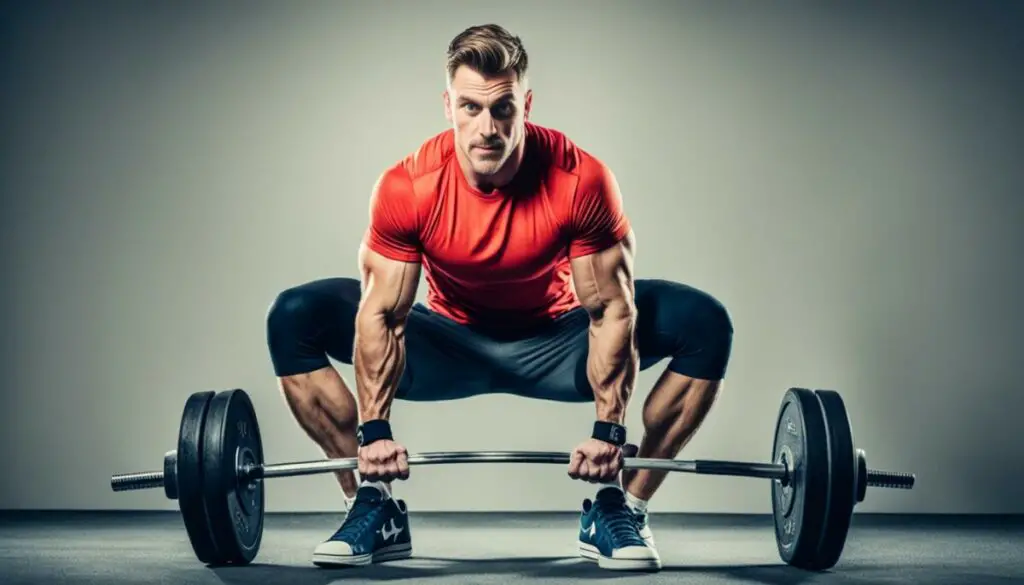
When it comes to choosing Converse shoes for lifting, both high tops and low tops can be suitable options. Let’s take a closer look at each:
Converse High Tops
Converse high tops offer additional ankle support, making them beneficial for individuals with weaker ankles or who are prone to ankle injuries. The high-top design helps stabilize the foot and provides extra cushioning around the ankle, offering enhanced protection during lifting exercises.
Converse Low Tops
Even Converse low tops provide better ankle stability compared to many other shoes. The lacing system of Converse shoes helps keep your foot in place, offering support and minimizing slippage. Despite having a lower profile, Converse low tops still provide durability and stability, making them a suitable option for lifting exercises.
Both high tops and low tops offer their own advantages, and the choice ultimately depends on your personal preference and needs. Whether you opt for Converse high tops or Converse low tops, you’ll enjoy the signature style and reliable construction that Converse is known for.
| Converse High Tops | Converse Low Tops |
|---|---|
| Provides additional ankle support | Offers better ankle stability compared to many other shoes |
| Stabilizes the foot | Foot remains secure with the help of the lacing system |
| Extra cushioning around the ankle | Lower profile but still offers durability and stability |
Whether you choose Converse high tops or Converse low tops, both options provide the durability and stability needed for your lifting routine.
Can You Wear Low Top Converse to Lift?
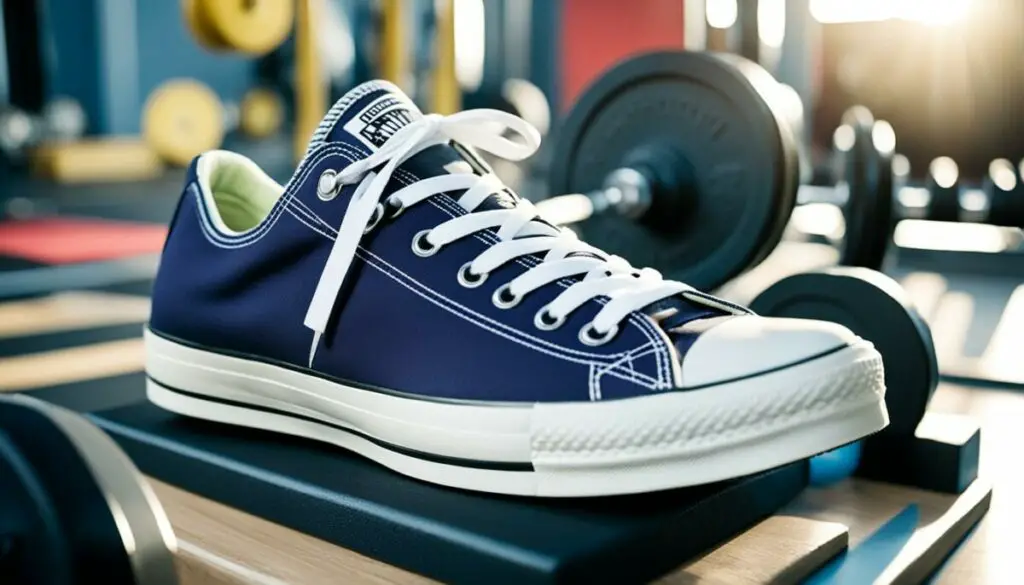
Yes, you can wear Converse low tops for lifting. While they may not offer as much ankle support as high tops, they still provide better stability compared to many other shoes. The lacing system of Converse shoes helps keep your foot in place, offering support and minimizing slippage. Low top Converse are versatile and suitable for various lifting exercises, making them a popular choice among lifters.
| Pros of wearing low top Converse for lifting | Cons of wearing low top Converse for lifting |
|---|---|
|
|
If you prioritize ankle stability during your lifting sessions and have weaker ankles or are prone to ankle injuries, opting for high top Converse might be a more suitable choice. However, if you feel comfortable and secure in low top Converse, they can still provide adequate support for your weightlifting routine.
Remember, the key is to find the right balance between ankle stability and comfort when selecting your lifting shoes. What works for one person may not work for another, so it’s important to listen to your body and make a choice that aligns with your individual needs and preferences.
Ultimately, the decision to wear low top Converse for lifting depends on your personal comfort, lifting style, and ankle stability requirements. Many lifters find low top Converse to be a reliable and functional option, providing the necessary support for their lifting sessions.
How to Maximize Ankle Stability with Low Top Converse
If you decide to wear low top Converse for your lifting workouts, here are some tips to maximize ankle stability:
- Ensure a proper fit by choosing the correct size and lacing your shoes tightly.
- Focus on maintaining proper form and technique during your lifts to minimize the stress on your ankles.
- Consider using ankle braces or wraps for additional support if needed.
- Gradually increase the weights you lift to allow your ankles to adapt and strengthen over time.
- Perform ankle-strengthening exercises as part of your training routine to improve stability.
Why Do Bodybuilders Wear High Tops?

Bodybuilders opt for high-top shoes, such as Converse high tops, for multiple reasons. These high-top shoes provide enhanced ankle support, which proves beneficial during weightlifting sessions and compound exercises. By stabilizing the ankle, they help minimize the risk of ankle injuries while offering additional cushioning. High tops also offer protection to the ankle joint during heavy lifts, reducing the likelihood of strains or sprains. Moreover, the stability provided by high-top shoes enhances overall lifting performance, promoting proper form and technique.
Bodybuilders choose high-top shoes like Converse high tops for their weightlifting needs. These shoes offer increased ankle support, stability during lifts, and protection against injury.
The History of Converse Shoes

Converse shoes have a rich history dating back to 1908. The first Converse shoe was created in Massachusetts, USA, and quickly gained popularity among basketball players. Charles “Chuck” Taylor joined Converse in 1921 and made improvements to the shoe, enhancing its flexibility and ankle support. The iconic All-Star logo was added to the shoe, and Converse All Stars became a staple for professional basketball players.
Over the years, Converse shoes have remained relevant and continue to be loved by people around the world. Nike acquired Converse in 2003, further solidifying its position as an iconic shoe brand.
Are Converse Good for Lifting? A Look at the Pros and Cons
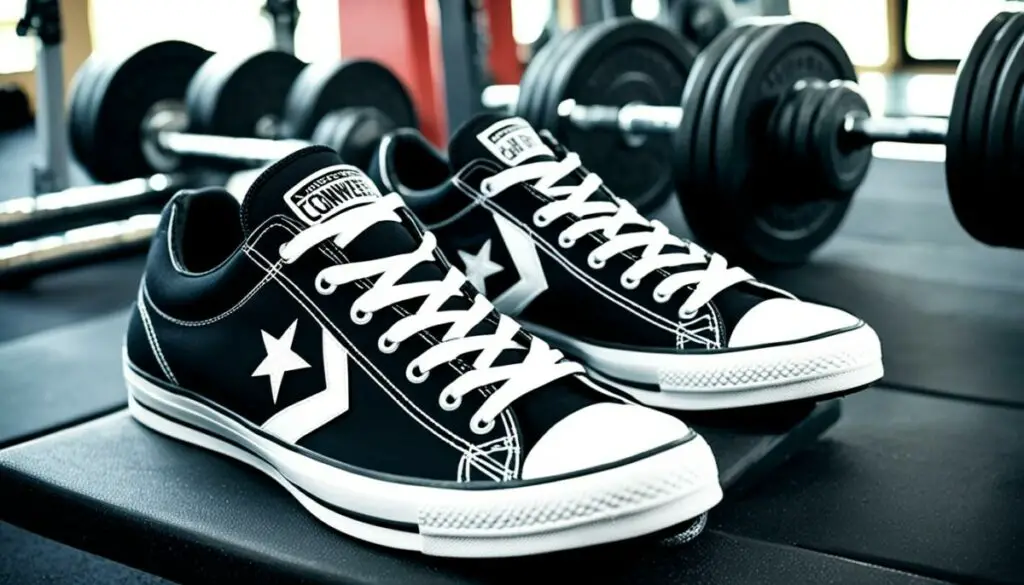
When it comes to lifting, there are valid arguments both for and against wearing Converse shoes. Let’s take a closer look at the pros and cons of incorporating Converse shoes into your lifting routine.
The Pros:
- Improved balance, technique, and stability: Converse shoes have a flat sole that allows for better control and balance during lifts. This can help improve your lifting technique and overall stability, allowing you to perform exercises more effectively.
- Ankle support and injury prevention: Converse shoes provide adequate ankle support, reducing the risk of ankle injuries during lifting sessions. They help stabilize the ankle joint, minimizing strain and enhancing safety.
- Back injury prevention: The flat sole of Converse shoes helps maintain proper alignment of the spine during lifts, reducing the risk of back injuries. This can be especially beneficial for those who struggle with maintaining proper form.
- Durable and breathable design: Converse shoes are known for their durability, making them suitable for the demands of lifting. Additionally, they offer breathability, keeping your feet cool and comfortable throughout your workout.
- Cost-effective: Compared to specialized weightlifting shoes, Converse shoes are more affordable, making them a cost-effective option for lifters on a budget.
The Cons:
- Lack of specialized support and cushioning: While Converse shoes provide some level of support, they may not offer the same level of cushioning and specialized support as dedicated weightlifting shoes. Weightlifting shoes often have raised heels, cushioned heels, and other features that cater specifically to heavy lifting.
- Minimal traction support: Converse shoes may not provide the same level of traction support as weightlifting shoes, which often have rubberized soles designed for optimal grip during lifts. This can potentially impact your stability and performance.
Overall, Converse shoes can be a suitable option for lifting, especially for beginners or intermediate lifters who prioritize balance, technique, ankle support, and cost-effectiveness. However, if you are a serious lifter or engage in heavy weightlifting, specialized weightlifting shoes may provide more robust support and cushioning for your specific needs.
It’s important to consider your individual lifting goals, preferences, and any specific requirements you may have before making a decision.
When Should You Avoid Wearing Converse Shoes for Lifting?
While Converse shoes can be suitable for lifting, there are certain activities where they may not be the best choice. Converse shoes are not designed for running, especially on treadmills or during high-intensity interval training. They lack the necessary stability and support provided by running shoes, which are specifically designed to absorb impact and protect your feet during running activities. If you plan on incorporating running or high-intensity interval training into your workout routine, it’s recommended to wear appropriate running shoes for optimal performance and to reduce the risk of injury.
“Converse shoes are not designed for running, especially on treadmills or during high-intensity interval training.”
While Converse shoes offer benefits such as a flat sole for improved balance and technique during weightlifting, they may not provide the necessary stability and support needed for running activities. Running shoes are specifically engineered to provide cushioning, shock absorption, and responsiveness to protect your feet and enhance your running performance. They feature specialized outsoles, midsole cushioning, and supportive features that promote proper running form and reduce the risk of injuries.
During high-intensity interval training (HIIT), which combines bursts of intense exercises with short recovery periods, the dynamic movements and rapid changes in direction require footwear that can provide stability and support. Running shoes are designed to offer stability for quick lateral movements and multidirectional activities, helping you stay balanced, reduce the risk of injury, and maximize your performance during HIIT workouts.
While weightlifting shoes, including Converse shoes, prioritize stability and a flat sole for lifting exercises, they may not provide the necessary cushioning and support for running activities. To prevent potential injuries and optimize your performance, it’s advisable to wear running shoes specifically designed for running and HIIT workouts.
Benefits of Wearing Running Shoes for Running and HIIT:
- Enhanced stability and support
- Improved shock absorption and cushioning
- Increased responsiveness
- Specialized outsole patterns for traction on various surfaces
- Designed for proper running form and gait cycle
- Reduced risk of foot, ankle, and knee injuries
- Optimal performance during running and HIIT workouts
It’s important to choose the right footwear for each activity to ensure safety, comfort, and optimal performance. While Converse shoes can offer advantages for weightlifting, it’s essential to wear appropriate running shoes when engaging in running or high-intensity interval training.
Best Converse Shoes for Lifting
When it comes to lifting, the right footwear can make all the difference. Converse offers a range of shoes that combine style and functionality, making them a popular choice among lifters. Two standout options for weightlifting are the Converse Lift and Chuck Taylors with a platform sole.
Converse Lift
The Converse Lift is an elevated update to the classic Chuck Taylor All Star high top shoes. With a 1.5″ platform outsole, it provides additional stability and style. The platform design offers increased comfort and support, making it a suitable choice for lifting.
Chuck Taylors with Platform Sole
For those who prefer a lower profile, Chuck Taylors with a platform sole are another excellent option. These shoes offer similar benefits to the Converse Lift, including stability, comfort, and style. Available in various styles and colors, they allow you to express your personal style while lifting.
When choosing the best Converse shoes for lifting, it’s important to consider your specific preferences and needs. Both the Converse Lift and Chuck Taylors with a platform sole offer the stability, comfort, and style that are essential for a successful lifting session.
“The Converse Lift and Chuck Taylors with a platform sole offer the stability, comfort, and style that are essential for a successful lifting session.”
Conclusion
When it comes to weightlifting and strength training, Converse shoes can be a reliable choice. Their flat sole enhances balance, technique, and stability, allowing for more effective workouts. The ankle support they provide helps minimize the risk of back injuries, while their durable and breathable design ensures long-lasting comfort.
While Converse shoes offer these advantages, it’s important to note their limitations. They may not have the same level of cushioning, raised heels, or traction support as professional weightlifting shoes. Therefore, it’s crucial to consider your specific needs and preferences, as well as the type of exercises you’ll be performing, before deciding on the right footwear for your lifting routine.
Overall, Converse shoes can be a cost-effective option for those looking to elevate their workout game. With their focus on flat soles, balance, technique, and ankle support, Converse Lift and Chuck Taylors are popular choices among lifters. Remember to assess your individual requirements and make an informed decision that aligns with your fitness goals.
FAQ
Why are Converse good for weightlifting?
Converse shoes offer a flat sole for improved balance and technique, superior ground reaction force, optimal outsole grip for better stability, high-top design for increased ankle support, and a durable and breathable design. They are also cost-effective compared to professional weightlifting shoes.
What are the drawbacks of wearing Converse for lifting?
Some drawbacks of wearing Converse for lifting include slightly more rigid midsoles, lack of raised heels, minimal cushioning, and reduced traction support compared to specialized weightlifting shoes.
What types of Converse are best for lifting?
Both Converse high tops and low tops can be suitable options for lifting. High tops provide additional ankle support, while even low tops offer better ankle stability compared to many other shoes.
Can you wear low top Converse to lift?
Yes, you can wear Converse low tops for lifting. While they may not offer as much ankle support as high tops, they still provide better stability compared to many other shoes. The lacing system helps keep your foot in place and minimizes slippage.
Why do bodybuilders wear high tops?
Bodybuilders wear high-top shoes, like Converse high tops, for increased ankle support, stability, cushioning, injury prevention, and protection during heavy lifts.
What is the history of Converse shoes?
Converse shoes have a rich history dating back to 1908. They were initially popular among basketball players and became iconic with the addition of the All-Star logo. Nike acquired Converse in 2003, sustaining its status as an iconic shoe brand.
Are Converse good for lifting? A look at the pros and cons.
Converse shoes offer benefits such as a flat sole for balance and stability, ankle support, durability, and breathability. However, they may not provide the same level of support and cushioning as professional weightlifting shoes.
When should you avoid wearing Converse shoes for lifting?
It is recommended to avoid wearing Converse shoes for running, especially on treadmills or during high-intensity interval training, as they lack the necessary stability and support provided by specialized running shoes.
What are the best Converse shoes for lifting?
The Converse Lift and Chuck Taylors with a platform sole are considered the best Converse shoes for lifting. They offer increased stability and comfort for weightlifting.
Conclusion
Converse shoes can be a good choice for weightlifting and strength training due to their flat sole, ankle support, stability, durability, breathability, and cost-effectiveness. However, they may not have the same level of cushioning, raised heels, or traction support as professional weightlifting shoes. It’s important to consider your specific needs and preferences when deciding if Converse shoes are the right choice for your lifting routine.

